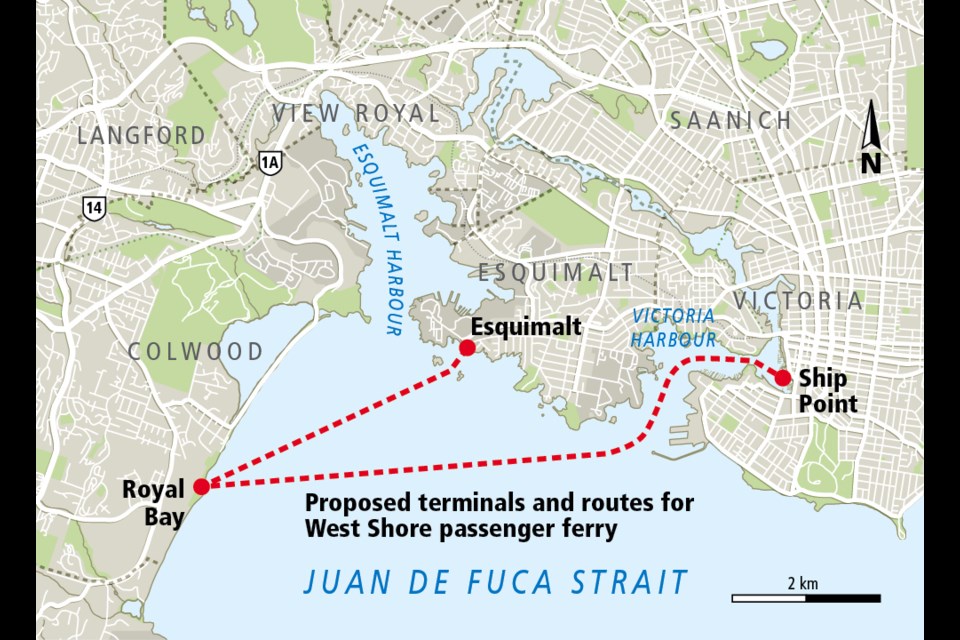Local mayors are welcoming a new report examining the potential for a passenger-only ferry service connecting downtown Victoria and the West Shore.
A study of a commuter ferry service by consultant SNC-Lavalin, commissioned by B.C. Ferries, suggests several options and ways to shave costs.
No decision has been made about the service, which is being considered as the West Shore population booms and Highway 1 clogs up.
Langford Mayor Stew Young said the ferry report fits with plans for a September transportation report from the province that will examine options such as restarting train service on the E&N line, adding high-occupancy-vehicle lanes and adding traffic lanes on the highway.
“I like the fact that they are looking at the ferry system, because I think that is an option that gets you direct with no stress — you don’t have to build the infrastructure,” Young said. “The water becomes your infrastructure. You just have to have the mode of transportation.”
A ferry running out of a terminal at the former quarry at Royal Bay would attract a community hub on the water’s edge and create economic development, he said.
Once the provincial report comes out, citizens will be able to evaluate the best transportation options, he said.
Colwood Mayor Rob Martin said the “pre-feasibility” study demonstrated that a ferry service is a viable option on the West Shore; he predicted a ferry service would remove 1,000 cars a day from local highways.
Victoria Mayor Lisa Helps called the prospect exciting. “I think it would be good for the region to be able to move people using the water.”
Helps said her support is conditional on the ferry targeting people driving cars, not those riding buses. “I think the aim should be to have less cars on the road with people taking buses and people taking ferries.”
One scenario would see the service operated with five diesel-fuel ferries. They would leave every 20 minutes between Royal Bay and Ship Point, each with room for 294 passengers, paying $2.50 per 28-minute ride. It would run 6 a.m. to 10 p.m.
There could also be a Royal Bay to Esquimalt route, with vessels leaving every hour from 6 a.m. to 9 p.m. But the report recommends against running that service right away, because demand would be too low.
Construction costs for terminals at Royal Bay, Esquimalt and Ship Point would total $41.6 million.
The Royal Bay site would cost $27.9 million, an Esquimalt terminal by the Pacific Fleet Club would cost $10 million, and upgrades to Ship Point would cost $3.7 million, the report said.
SNC-Lavalin approached two shipbuilding firms but heard back only from Damen Shipyards, an international shipbuilding company based in the Netherlands, which proposed using an existing design for a vessel at 106 feet (32.3 metres) long, with a top speed of 25 knots.
It estimated that in 2021, the service would carry 3,077 passengers daily and generate annual revenues of $2.59 million.
By 2038, the daily ridership could reach 4,019, for annual revenue of $3.39 million.
Buying five vessels would cost just under $54 million.
Having five ships operating two routes would result in yearly losses of more than $8 million, said the report, which recommends exploring financing and joint-funding options with organizations that would share in benefits of a ferry service. It did not suggest any particular organizations.
Another option to save costs is running two ferries at 40-minute intervals, which would reduce infrastructure needs at Ship Point. The service could also use smaller ferries that would run four hours in the morning and four hours in the afternoon and evening, it said.
B.C. Ferries spokeswoman Astrid Braunschmidt said the company is at the “very preliminary stage” in determining the feasibility of a passenger-only service between Victoria and the West Shore, and is reviewing the study’s findings.
The 201-page report has been sent to stakeholders for feedback, she said. Its cost was not released.
SNC-Lavalin is among the world’s largest construction and engineering firms.
The Quebec-based company has been at the centre of controversy in Ottawa over whether the Prime Minister’s Office tried to interfere with a possible criminal trial involving the company.



